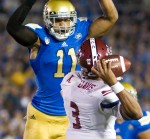When coach Jim Mora first came to UCLA, he realized the football facilities weren’t “the nicest,” but by no means were they the worst he’d ever seen.
Back in the early ’90s when Mora was a defensive backs coach with the New Orleans Saints, the team’s facilities on David Drive left a lot to be desired. One day in 1995, a malfunctioning sauna caused much of the building – constructed in 1967 – to go up in a two-alarm fire. The team’s operation was placed in trailers in the interim, a move Mora called “an upgrade.”
On Tuesday, the process to widen the gap between Mora’s ’90s and current football homes officially began. In a statement released today, UCLA announced an effort to raise private funds for a football training complex to be constructed just west of Spaulding Field, adjacent to the current Acosta Athletic Training Complex.
The project is expected to cost $50 million and the university is still looking for an architect, who will work with Athletic Director Dan Guerrero and Mora to develop renderings of the facility.
The new training facility is expected to include a locker room, meeting rooms, coaches’ offices, strength and conditioning areas, athletic training rooms, video rooms and “several elements that will feature the storied history of UCLA football,” the statement read.
With the UCLA football program moving into a new facility in the future, plans have also been included to renovate current strength and conditioning areas, student-athlete academic tutoring sections, and nutrition and dining facilities to accommodate UCLA’s other athletic programs.
“This is an exciting project that will continue to propel UCLA football forward by allowing our coaches and student-athletes to teach, learn and develop in a state-of-the-art facility,” said Guerrero in the statement. “We are working alongside our campus facility team to create a complex which complements (Mora’s) vision for our football program.”
Mora said that despite UCLA’s campus, location and generally nice weather, the enormous benefit of new facilities, especially from a recruiting standpoint, helped the football program ditch the status quo.
“Facilities do become important, the aesthetics become important. To some kids, uniforms become important, academics are important, having a winning team is important,” Mora said. “We’re going to make it as nice as it can be and it’s for the players, for their benefit.”
Off Target
Saturday’s game against New Mexico State gave UCLA its first real exposure to the NCAA’s new targeting rule.
In the Bruins’ first drive of the third quarter, with UCLA already leading 31-0, redshirt senior wide receiver Shaquelle Evans was running full speed near the right sideline. A pass from redshirt sophomore quarterback Brett Hundley sailed just beyond his outstretched fingertips when Aggies safety Anthony Edwards, a split second earlier not in Evans’ line of vision, drilled him in the head.
The target earned Edwards an ejection for the remainder of the game as well as a suspension for the first half of New Mexico State’s upcoming game against San Diego State. Evans said that although he never saw the blow coming and that the play deserved a flag, it didn’t injure him in any capacity and hits to the head should not warrant an ejection.
“He hit me late. Like, he hit me late, late. He didn’t have to do that,” Evans said. “I don’t think they should be kicked out of the game for it, but they should definitely get flagged, especially for something like that, where it was really like the ball isn’t even complete, what are you hitting me for?”
UCLA nearly saw one of its own, senior outside linebacker Anthony Barr, ejected four plays later for a hit to the chest of quarterback King Davis III. An unblocked Barr arrived just tenths of a second after Davis III released the ball with his head not completely up, and was questionably flagged for a 15-yard roughing-the-passer penalty.
Mora, who talked with Pac-12 officiating coordinator Tony Corrente about the hit yesterday, said it was a “good hit,” and that judgment calls like the enforcement of the targeting rule are especially difficult given that they happen in real time at full speed.
“It’s easy when you watch it on film and you slow it down and analyze it, but things are happening so fast on the field, it’s something you just have to constantly talk to your players about and you have to drill it,” Mora said. “It’s a tough rule, but it’s the rule and I think ultimately it’s a good rule because it’s about player safety.”
